|
A Question of Ballast
Protecting Ships, Preventing Species Invasions
JESSICA SMITS
THE WIND KICKS UP OVER BALTIMORE HARBOR and sends a hard hat flying along the dock. March is going out more lion than lamb. From behind a gritty industrial building come three U.S. Coast Guard inspectors striding along in matching navy-blue jumpsuits. They walk with authority to a black-and-white cargo ship docked in the Patapsco River along the Domino Sugar pier. The ship has come to the refinery to deliver 15,000 metric tons of Mexican sugar. The Coast Guard has come unannounced.
The inspectors walk along the dock checking the condition of the twenty-two year-old ship. Block letters painted white on the black bow spell out its name and origin: Tamoyo Maiden. Manila. One officer lifts a tarp on the side of the ship to eyeball the hull's level in the water. It's all part of a Port State Control Inspection to see whether a foreign ship is complying with United States and international maritime laws on safety, security — and the environment.
A bakery-sweet smell spices the air as the inspectors climb to the main deck, the bright orange steps sticky under their black steel-toed boots. At the top, members of the Tamoyo's Filipino crew check their identification, then quickly escort them to the captain.
Victorino Escoto aims to please his visitors. The slight captain greets them eagerly and smiles often. Standing by, his burly chief mate offers sodas from the captain's fridge, the familiar red Coca-Cola can accented with Asian characters from a faraway port. Courteous but all business, the Coast Guard inspectors ask to see the ship's documentation.
Captain Escoto gathers several overstuffed binders and lays them on a table for the Coast Guard to review. Each binder contains sets of meticulously organized documents, mostly pertaining to things like crew lists, emergency procedures, voyage logs. But one of the first binders examined has an environmental purpose: the Ballast Water Management Plan.
While the captain and crew tend to the inspectors, dockworkers operate mechanical claws, grabbing sugar out of the ship's large red bins and dumping it onto a conveyer belt heading into the refinery. When the unloading is complete, the Tamoyo Maiden will depart empty. Empty that is, except for water.
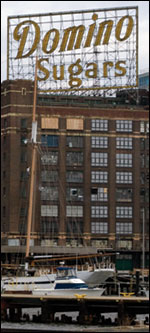 |
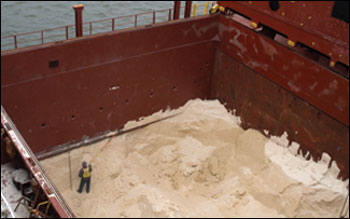 |
|
Longtime Baltimore landmark, the Domino Sugar refinery takes Mexican sugar from the Tamoyo Maiden, a freighter flagged in the Philippines (left). Like a kid in an oversized sandbox, a dockworker scrapes raw sugar from massive bins in the ship's hold (above). When the sugar's gone, the Tamoyo will take on ballast water from the Patapsco River before heading out to sea. Credit: Jessica Smits. |
To prepare for the ship's next journey, Chief Mate Rodelito Lardizabal will direct crewmembers to fill the ship's ballast tanks with Patapsco River water. Without ballast water and without cargo, Lardizabal says, the ship's propeller and rudder may not even sink below the surface. Water weight provides stability and maneuverability to the Tamoyo — and to hundreds of other ships in the global fleet that travel with ballast water every day.
But when the crew of the Tamoyo Maiden fills its ballast tanks alongside the Domino pier, they'll bring more aboard than water. Grates on the intake pipes will no doubt keep out large fish, but smaller organisms — larvae, algae, microbes, cysts — will likely slip through as unwitting stowaways. When discharged in another port, hitchhikers like these can cause ecological catastrophe.
In 1982, the comb jelly, Mnemiopsis leidyi, arrived in Europe's Black Sea in ballast from North America — perhaps even from the Chesapeake Bay. The comb jelly functions as an important component of the food web in the Chesapeake, but in Europe its insatiable appetite was blamed for decimating fisheries already in decline.
In 1988, the zebra mussel, Dreissena polymorpha, a native of the Caspian Sea region, first showed up in the North American Great Lakes. Since then, this colonizing filter feeder has cost billions of dollars in damages by clogging infrastructure at places like water treatment facilities and power plants.
Global shipping is the prime mover behind most aquatic invasions, according to Greg Ruiz, one of the world's leading "invasion ecologists." As the head of the Marine Invasions Research Laboratory at the Smithsonian Environmental Research Center (SERC), Ruiz sits at the hub of invasive species research in the Chesapeake and beyond. Organisms arriving in ports aboard ships — whether in ballast or attached to hulls — often find an ecosystem already degraded by intense human activity. He thinks debarking into a degraded environment may make it easier for a non-native species to establish itself as an invader.
The comb jelly and zebra mussel invasions brought national and international attention to ballast water's role as a pathway for the introduction of non-native species. Decades later, scientists and managers are still asking — how can we protect the environment and keep ships moving safely around the globe?
Fate Hangs in the Ballast
Three months before arriving in the Chesapeake Bay, the Tamoyo Maiden's crew filled nine of twelve ballast tanks with water from the port of Onsan, South Korea. Steel products on board provided additional weight. After stopping to offload goods in several countries, the ship arrived in Coatzacoalcos, Mexico, where it picked up sugar bound for Baltimore and emptied its nine tanks. But the water it discharged in Mexico was not from Korea.
Along its route, a little more than halfway between Japan and Hawaii, the ship opened its valves and turned on its ballast pumps. Seawater from the middle of the Pacific Ocean rushed into the tanks, forcing out Korean coastal water. The entire process — so-called "mid-ocean exchange" — took several hours. This swapping of water was done for one reason: to avoid potential invasion by non-native species.
|
Pathways for Invasion
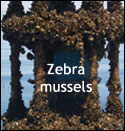
BALLAST WATER ISN'T THE ONLY WAYthat non-native species move from place to place. How we work and play and even some of our cultural traditions can all contribute to the spread of potentially invasive animals, plants, and microbes. The study of these pathways — a field called vector ecology — has emerged as a key part of efforts to avoid species invasions. Here’s a look at some of the top vectors on the minds of scientists and managers — hull fouling, live trade, fishing gear, water gardens, and intentional introductions.
Hull Fouling
While organisms transported inside ballast tanks seem to garner the most attention, those attached to the outside of a ship may be equally — or more — to blame. [more] |
The theory behind ballast water exchange is that organisms suited to the saltier open ocean will not survive in coastal environments and, in turn, that coastal organisms won't survive the high seas. In 1993, in response to the zebra mussel invasion, the United States first mandated that ships coming from foreign ports to the Great Lakes exchange ballast water offshore. In 1998, they broadened their reach and called for all vessels entering any U.S. port from abroad to voluntarily exchange their ballast water outside the Exclusive Economic Zone (EEZ) — at least 200 nautical miles offshore. After low voluntary compliance, exchange became mandatory in 2004. The United Nations International Maritime Organization (IMO) calls for similar action.
Ruiz finds "very convincing evidence" that these policies have reduced concentrations of coastal organisms in discharged ballast. He believes that ballast water exchange has likely prevented invasions.
He's also quick to point out exchange's shortcomings. Residual coastal water and organisms can stay behind in ballast tanks, even after exchange. Just how many foreign organisms remain, and what they mean for the risk of invasion, is highly variable and subject to debate.
Ruiz also notes that exchange is not always practical for seagoing vessels, and often not required. According to an analysis by the U.S. Coast Guard, about 65 percent of all ships arriving to U.S. ports from outside the EEZ don't have to exchange ballast because they didn't travel more than 200 miles from any shore. This can include ships coming up from South America and passing through the Caribbean, for example. The number of ships not exchanging ballast is even higher when you include coastwise vessels — ships visiting ports along the same coast.
And then there's the issue of safety.
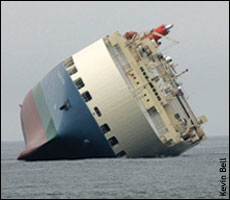 |
Disaster at sea can result if ballast tanks fail. That's what happened to the car carrier, Cougar Ace (left), during an open-ocean ballast exchange. While such accidents are rare, many see them as one more reason to find an alternative to exchange. Intense scrutiny marks the face of U.S. Coast Guard Ensign Jerome Brown as he studies the Tamoyo Maiden's records, with Captain Escoto looking on (above, right). A three-hour port inspection of the ship includes reviewing ballast water management documents and examining the trim of the hull (above, left). Credits: above by Jessica Smits and Cougar Ace by Kevin Bell. |
In July 2006, the Cougar Ace, a car carrier on its way from Japan to North America, began ballast water exchange off the Aleutian Islands. When its starboard ballast tanks failed to refill properly during the exchange, the huge vessel rolled to the portside, unable to right itself. Tragically, one rescuer died in the salvage effort.
To guard against accidents like this, regulations allow exceptions for safety when — during bad weather, for example — conducting an exchange could jeopardize the ship or crew.
Kathy Metcalf, director of maritime affairs at the Chamber of Shipping of America, thinks ballast water exchange is problematic in any situation. She has strong feelings about the requirement. "Exchange," she says, "is horrible." She adds that ballast exchange burdens the crew, who should be concentrating on safely operating the vessel, and that it doesn't provide sufficient protection to the marine environment.
Metcalf's opinion matters. An attorney and former ship officer for Sunoco, she now represents the shipping industry before Congress and is a member of the U.S. delegation to the IMO's Marine Environment Protection Committee. But it's not that she thinks ballast water shouldn't be managed. "The environment deserves it," she says.
She just sees another way. "The shipping industry in general would prefer to have economically viable, environmentally beneficial treatment systems."
Don't Exchange It, Treat It
Just around the river bend from the Domino Sugar refinery, the MV Cape Washington sits in ready reserve. The slate-gray behemoth serves the Maritime Administration, an agency often tasked with supplying food for humanitarian efforts and bringing resources to the military overseas. If called upon, the Cape Washington can ship out in five days. On its last mission, the roll-on roll-off carrier ferried equipment to Iraq — humvees, helicopters, tanks — and returned home with similar items in need of repair. But now the Cape Washington is helping with a different sort of mission.
Deep in a corner of its cavernous underbelly, a maze of pipes and hoses has replaced military equipment. A team of casually dressed biologists and engineers scurries about, apparently oblivious to the stench of fish and sludge that sours the air. This test facility is part of the Maritime Environmental Resource Center (MERC), an initiative launched by the University of Maryland Center for Environmental Science (UMCES) and the Maryland Port Administration. Their goal? Address environmental issues facing the shipping industry. Priority number one: ballast water.
Mario Tamburri, a researcher at the UMCES Chesapeake Biological Laboratory, directs the Center. He talks fast and exudes enthusiasm. "Ships were not meant to do this," he says, referring to ballast water exchange. "It was an interim solution."
For well over a decade, Tamburri and others have worked on what they think could be a better solution: treating ballast water to eliminate the life within it. Filters, oxygen strippers, UV rays, biocides — no matter the method, the idea is the same. An effective treatment system could remove invasive species while abolishing the need for exchange at sea.
It's an idea that's recently gained significant traction with environmentalists, governments, and the shipping industry alike.
|
Maritime Environmental Resource Center director Mario Tamburri (top) oversees testing of ballast water treatment systems. New technologies come in large containers like the one housing the filterUV apparatus (bottom left). George Smith tests treated water with a probe, while Tim Mullady records the results. The two Smithsonian Environmental Research Center biologists form part of a multi-institutional team studying how treatment systems affect ballast water. Credit: Jessica Smits. |
MERC was launched after the Maryland Port Administration and Congressman Elijah Cummings approached UMCES president Don Boesch about tackling the issue of ballast water and invasive species. The Port had funded projects involving treatment technology in the past, but the trend was moving away from individual scientists' academic projects and toward real-world implementation.
|
Navigating Ballast Water Management
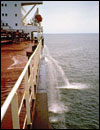
OVER THE PAST TWO DECADES, managing the discharge of ballast water has evolved into a complicated tangle of international, federal, and state law — and lawsuits. Here's a glimpse at what's happening now.
International
While organisms transported inside ballast tanks seem to garner the most On the global stage, the International Maritime Organization, a United Nations agency focused on shipping safety and pollution, has developed a legal framework to regulate ballast water. [more] |
In the real world, standardized testing is key. Otherwise systems won't win approval, or certification, from flag states around the globe. As part of an international convention for managing ships' ballast water, the IMO has issued guidelines on testing and a "discharge standard" for treatment systems (see Navigating Ballast Water Management to the left). But companies that develop the technology don't necessarily have the expertise to measure biological effects — things like how much life remains in the water and how discharge of treated water may affect surrounding water quality. With experienced biologists from area institutions like the University of Maryland and the Smithsonian Environmental Research Center onboard, Tamburri says, MERC can answer these questions.
MERC solicits applications from technology companies who want to test a system in order to move it along in the approval process. And as an independent third party, Tamburri notes, MERC lends credibility to the test results. "You don't want an infomercial from the company."
With the onset of spring blooms of plankton in the Chesapeake, MERC has just begun its second season of testing. According to Tamburri, the Bay provides ideal conditions to challenge the systems because a mixed bag of phytoplankton and zooplankton abound from spring through fall. The system under review today will use a filter and UV light — a one-two punch to remove organisms from the water.
The Cape Washington's ballast tanks are each filling with water from the Patapsco. The turbid water, rich in life, enters the ship and then splits into two separate obstacle courses of piping.
One pipe sends the water straight into the starboard tank — the experimental control. The second pipe includes a detour to a white box, about the size of a small trailer, containing the treatment system. Before entering the portside tank, the water moves through the filter to remove sediment and organisms larger than about the size of a speck of pollen (25 microns). Then the water courses through a stainless steel drum containing bulbs of high intensity UV light. The UV rays pulse the water before it finally enters the portside ballast tank.
While engineers monitor the flow through the treatment system, biologists divert about one cubic meter of untreated ballast water into a large plastic jug. Once the jug is full, they work quickly to collect samples for a whole suite of analyses.
They dip a probe into the tea-colored water to measure physical properties like temperature, acidity, dissolved oxygen, and salinity. This afternoon they'll examine samples under a microscope to identify and count the living organisms.
Additional samples will go back to the lab for chlorophyll analysis and tests for bacteria. All together, this collection of work will show the initial conditions of the untreated water.
The team then does the same for water that's passed through the treatment system. This gives them a read on the conditions of the water soon after it courses through the filter and UV rays.
Water stays in the two ballast tanks for five days, mimicking the length of an average journey at sea.
When they return the next week, the MERC team begins to pump out the tanks. They carry out the exact same protocol as they did days before, gathering data on how life and conditions within the two tanks have changed over the holding period.
As they prepare for sampling, they take a look at treated water running out of blue hoses into a tub. "Looks good enough to drink," one of the biologists quips. Although this quick assessment is not a judgment on the system's success, the contrast is stark between the brown, smelly untreated water that came in the pipes last week and the clear treated water now flowing through the hoses.
Did this filter combined with UV radiation work?
Roadblock to Implementation
MERC can answer only part of that question. They'll compile data from the trials and provide results to the company developing this treatment system and to any governments or organizations it requests. But after they provide the data, it'll be up to others to decide whether this treatment method meets their standards and whether to allow it as an alternative to exchange. And that road gets complicated.
If the results from the MERC tests look promising — that is, if they meet standards set by the IMO — this filter-UV treatment system will move into the shipboard testing phase. This requires operating on a ship at sea under real-life conditions. Success there means the developer can ask a ship classification society, such as the American Bureau of Shipping, to approve the system as technically sound and safe for use on a ship. From there, the company will approach flag states for certification as a ballast water treatment system that meets IMO standards and requirements.
For now, one thing is certain. The United States will not be approached for certification. The federal government currently does not recognize treatment as a ballast water management tool — exchange is the only option.
Mario Tamburri notes that the first treatment technology to be certified was a deoxygenation system developed by NEI Treatment Systems, based in Los Angeles. Although the system was tested using federal grants from the National Oceanic and Atmospheric Administration (NOAA), NEI could not seek approval for use in the United States because the U.S. does not yet have a procedure in place for approving systems. So, Tamburri says, the U.S.-based company packaged all their information and submitted it to Liberia — commercial shipping's second largest flag state.
According to Coast Guard biologist Rich Everett, the U.S. is moving toward replacing exchange with treatment. Everett has been involved in writing regulations to that end. He acknowledges that the Coast Guard has finished drafting regulations and that they're going through a formal review process with other agencies. How close are they to publishing it as a proposed rule? Everett would not comment except to say that it's impossible to predict because of the many important issues facing the government.
Tamburri is hopeful that publishing the regulations is imminent, within the next year or so. Meanwhile, some states have given up waiting for the federal government and have created treatment regulations of their own (see Navigating Ballast Water Management).
Coastwise Coda
Just a few weeks before MERC's trials began for the season, the Tamoyo Maiden took in untreated water — no doubt packed with microscopic life — less than a mile from where the Cape Washington sits. Captain Escoto expected that their next port of call would be Lake Charles, Louisiana. As a coastwise voyage the ship would not be required to exchange its ballast water. In order to take on their anticipated cargo, the crew planned to discharge their Baltimore Harbor water into an artery of the Gulf of Mexico — an entirely different ecosystem from the Chesapeake Bay.
Tamburri sees these types of coastal voyages, where exchange is not required, as potential for trouble. He thinks the biggest issue is that once there's an invasion in a place like the Chesapeake Bay, it spreads through coastal routes, resulting in secondary invasions.
The Coast Guard's Rich Everett agrees. He doesn't know of any biological evidence that shows coastwise transport of ballast water poses less of a risk for introducing or spreading an invasive species than transoceanic ballast transport.
|
Rapid Response Planning

While preventing invasions is key, managers must also be prepared to take action when prevention measures fail. To foster an effective response to aquatic invasive species introductions, Maryland Sea Grant and the Mid-Atlantic Panel on Aquatic Invasive Species worked with their partners to produce Rapid Response Planning for Aquatic Invasive Species.
The rapid response plan employs Incident Command System (ICS), a response framework best known for its application to environmental disasters like wildfires and oil spills. ICS provides a common language and a step-by-step approach to organizing response efforts. It aims to help individuals from various agencies and jurisdictions work together as a well-coordinated unit. Use of ICS for invasive species incidents — a relatively new endeavor — is backed by the congressionally mandated Aquatic Nuisance Species Taskforce.
The Rapid Response Plan is available in two formats: (1) A Template and (2) A Maryland Example.
The template is available as a Microsoft Word document to encourage states in the Mid-Atlantic and beyond to adapt the plan to their specific needs while maintaining a common framework across the region. Maryland was the first state to complete the template, and its resulting plan is available for use as an example. Anyone may download both the template and Maryland example at www.mdsg.umd.edu/rapidresponse. The state of Delaware has also used the template and is currently finalizing its plan. |
West coast states have addressed the issue by requiring most coastwise ships to undergo exchange at 50 nautical miles offshore. Everett says this is considered effective on the west coast because the continental shelf is narrow and a ship can be in deep oceanic water — rather than coastal water — without having to detour too far out of the way. The oceanographic conditions created by the narrow shelf also reduce mixing of offshore and inshore waters. All of this decreases the likelihood that non-native coastal organisms discharged only 50 miles out would wind up reaching inshore habitats.
On the east coast, the continental shelf is much broader, and vessels have to venture farther offshore for effective exchange, an impractical option on coastwise trips.
Tamburri and Everett think that if treatment becomes mainstream it could help solve issues like this. A treatment system could operate without forcing a ship to divert from its course or to carry out a risky exchange. A win for industry. And a treatment system could run in situations where exchange is not required. A win for coastal environments.
The Tamoyo Maiden never made it to Louisiana. Before leaving Baltimore, Captain Escoto got different orders — not unusual in an industry whose logistics depend on the dynamic flux in demand for goods around the globe. The change in itinerary sent the cargo ship up the Atlantic coast to the Saint Lawrence River and on to Montreal. The Gulf of Mexico got a reprieve from Baltimore water. At least this time.
Along the way to Montreal, hundreds of miles off Long Island at the edge of the continental shelf, the Tamoyo once again opened its valves and turned on its ballast pumps. Water from the Atlantic Ocean flowed into the tanks, and a piece of the Patapsco River flowed out into the sea.
Canadian law called for this exchange. The St. Lawrence has been burned before. Years ago, a ship headed toward the Great Lakes entered here, unaware that it carried the devastating zebra mussel in its ballast tanks. For now, ballast exchange provides some defense again the next invasive mussel or crab or microbe. But it is an imperfect defense, and many hope that there will soon be a better one.
|